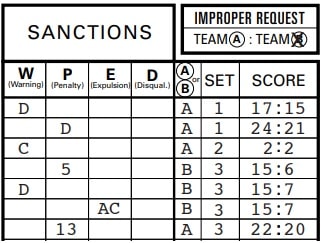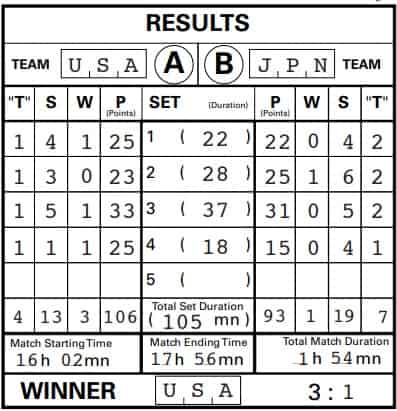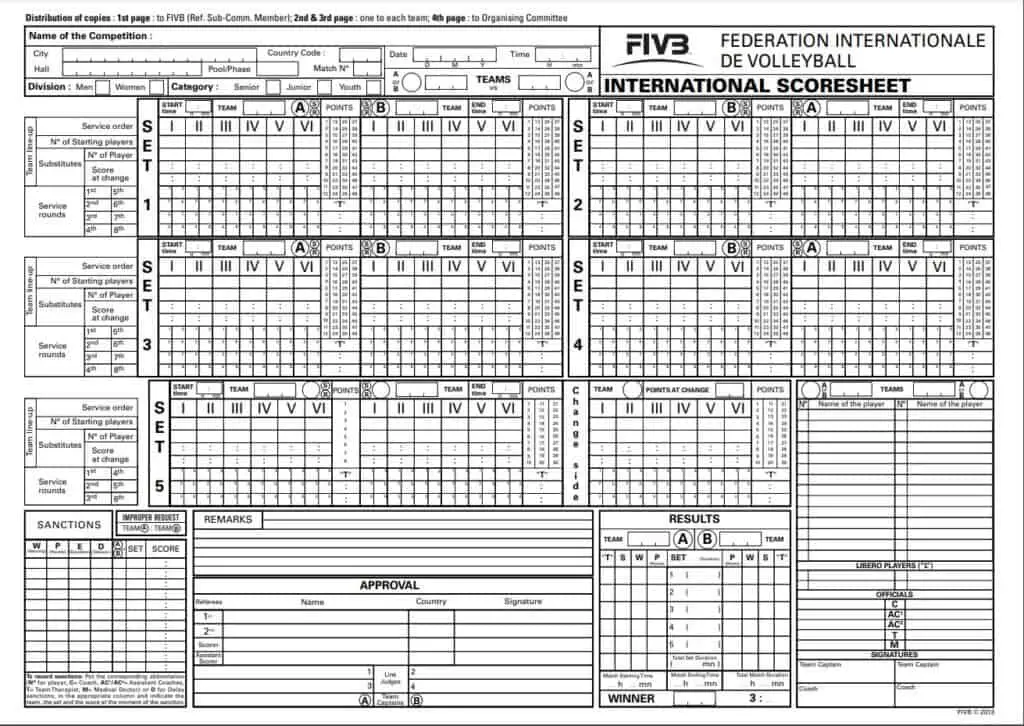The first time I saw a volleyball score sheet I nearly fell off the chair, they were crammed full of boxes, numbers and text.
Just looking at them was confusing enough and it only got worse when I realised I actually had to score one and fill them out.
Now I was using the FIVB (official governing body of Volleyball) score sheet and luckily (or so I thought) the back of the score sheet had a full guide on exactly how to fill them.
As I was reading through this labyrinth of instructions and started to piece together section by section what was required I couldn’t help but think that the instructions were just unnecessarily complicated.
So with that I thought if I struggled when I first started using them, the chances are lots of people struggled too.
So in this article I am going to try to go step by step through the score sheet so that when it comes time for you to fill out a sheet you know exactly what to do.
A score sheet is broken up into 4 different categories (not that you would know from looking at it), but these categories simply put are as follows:
- Before the Match
- After the Serve/ Receive is Determined
- During the Match
- After the Match
Using the above 4 categories I will work my way through each section of the score sheet highlighting where it can be found on the sheet and what you must do in each section.
Once you know how to score and you’re ready to dive in and start playing, click here to get all your volleyball essentials from Amazon
So let’s dive into it.
Table of Contents
Before The Match
The first section is actually situated where you would expect it to be and that is the formalities noted in the Name of competition section
The Name of Competition section can be found at the top of the score sheet in the top left corner, refer to the below highlighted image for clarity.
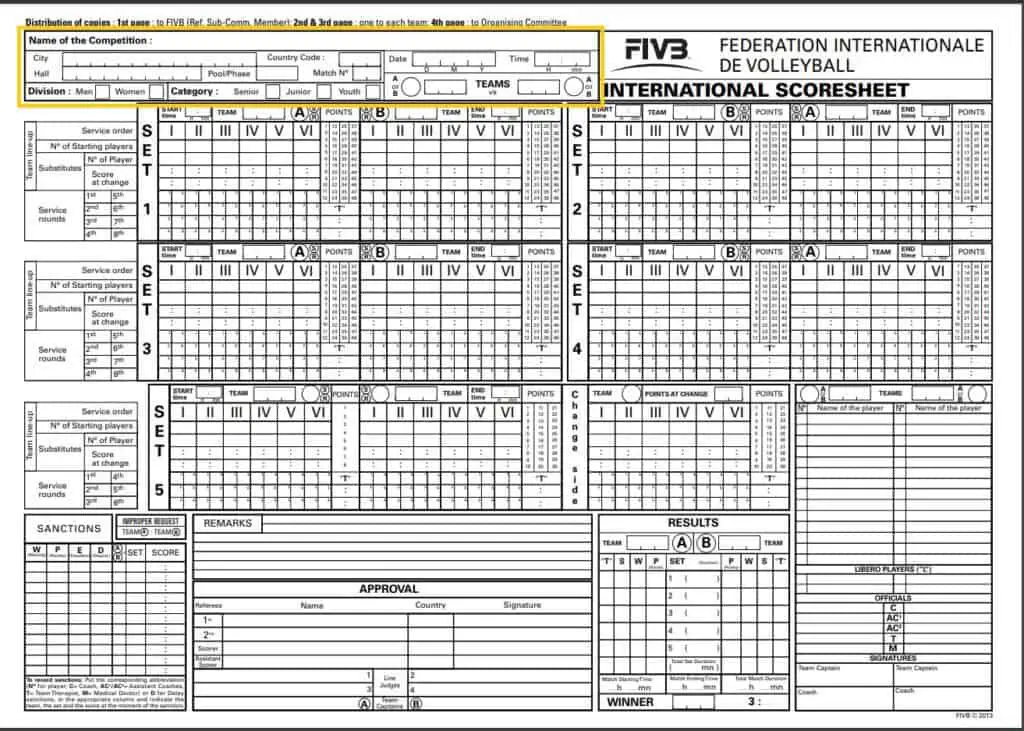
In this section you will see the below noted items:
- Name of Competition
- City and Country Code
- Hall
- Pool/ Phase
- Match No.
- Division
- Category: Senior, Junior, Youth
- Date (Day, Month, Year)
- Starting Time
- Teams

So what exactly do these all mean?
Now many of them are self explanatory yes but honestly some are quite vague and you may be scratching your head as to what exactly you input.
Just so you are perfectly clear as to what is required I am going to work through each question and give an example.
Name of Competition
The name of competition is as it suggests, you are to put in which competition the match is being played for example I may enter: Volleyball Nations League
City and Country Code
This again is as the name suggests, it requires that you put a city and country code. An example may be NINGBO BEILUN – CHN
Hall
Im sure you can guess but this basically asking for the venue name/ location. Now admittedly I don’t know what the hall is called where the match noted above is being played so for this example I will make one up and in this box I will put: The International Centre
Pool/ Phase
This simply means at what stage in the competition is the match out, for example is it a qualifier, a pool game, a semi-final or final, for this example I will say it is a Pool match
Match No.
This relates to the what match on the schedule (that is put together before the competition) is being played. In this example I will put 01
Division
This relates to the gender of the competition, is it Mens or Womens, once decided this should be indicated using a tick: ✔
Category
Thanks to the boxes that following this heading it is nice and straight forward and makes it easy to determine what is required.
Unlike Division this should be indicated using a cross: ✖
Date
As this is the FIVB score sheet the date should be displayed in a day, month, year format.
02/09/2020
Starting Time
This should be the time in which the match/ event starts, however, normally the starting time will be the time that was initially noted on the schedule.
15:30
Teams
Where it states teams it obviously is not wide enough to write the team’s entire name unless it is extremely short so here you will want to write abbreviations.
Where an international tournament is being played this is much easier however lets say for example the teams playing were as follows: Pickle Penguins VS Redhawk Pancakes
We may want to abbreviate their names to the following; PPN VS RHP
Once Name of Competition has been completed we move on to the next part in the prematch section and that is the Teams section located in the bottom right corner (Confusing I know)
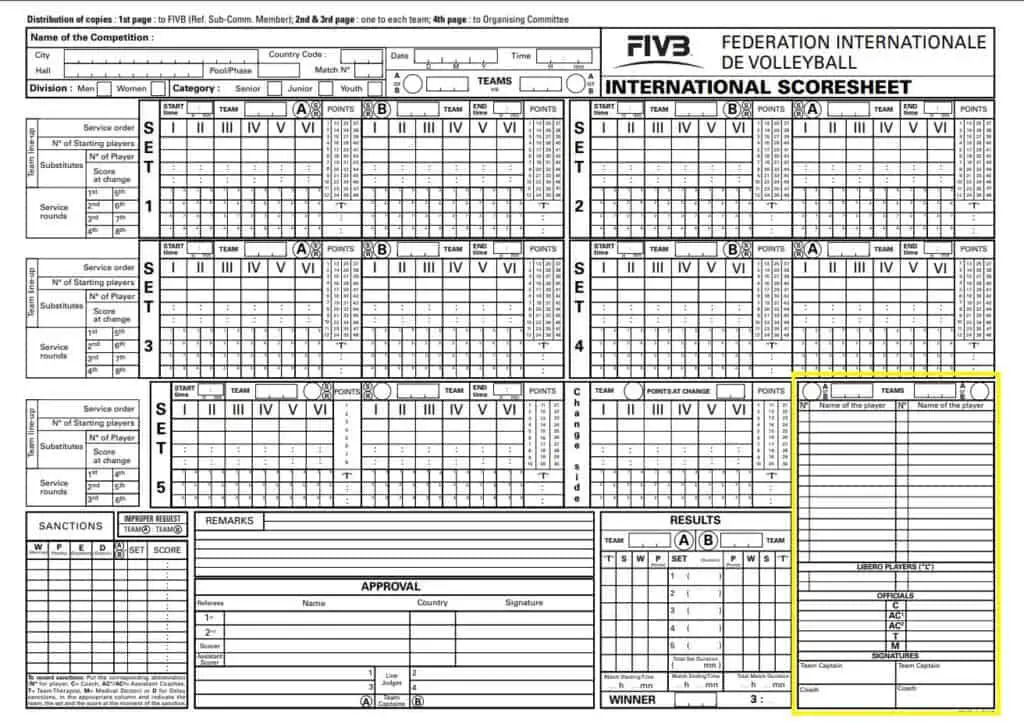
Now if we take a closer look at this section we will see the following:
- Teams
- Number & Name of Player
- Libero Players (“L”)
- Officials (C, AC1, AC2, T, M)
- Signatures (Each Team Captain & Coach)
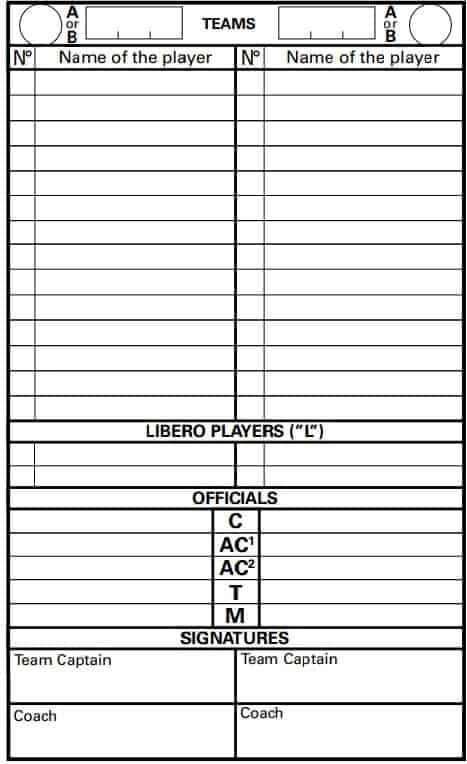
Now although this is located in a much more confusing location as it follows no logical order, fortunately I think filling out this section is a lot more obvious and clear than the first section.
Much like the first section I will go over each line item and detail what is expected and an example of each
Starting at the top we have Teams
Teams
This is actually exactly the same as the top section where we are expected to put abbreviations of the team names. Using the example above I would put PPN VS RHP
Number & Name of Player
Fortunately this is another line that is quite self explanatory.
In this line we are to the number of each player and then the corresponding name.
When filling out this section the captain on each team is indicated by circling the number of the relevant player
12 – John Smith
5 – Adam West
2 – Steve Palmer
etc..
Libero Players
This section is used to note Libero players that may be not be in the starting lineup but are reserves and still have a chance of getting court time
25 – Jessica Morna
Officials
Now you may have guessed from the Letters left next to the section but this section is used for the staff of each team. C represents the Coach, AC1 represents the assistant Coach, AC2 Represent the 2nd Assistant Coach (If applicable), T represents Team Therapist and lastly M represents Medical Doctor.
C – Cindy Starfield
AC1 – Alex Mortez
AC2 – Ellie Sin
T – Natasha Brown
M – Sarah Monty
Signatures
This is obviously reserved for signatures from the team representatives these include the Team Captain & Coach
The signatures are required to sign off that the above information is in fact correct and true to the best of their knowledge.
Adam West
Cindy Starfield
The last part required before moving onto the next category is the section knows as Approval
The Approval section again is not logically positioned when it comes to what order it is filled in however it can be found in the lower left portion of the page.
See below for position.
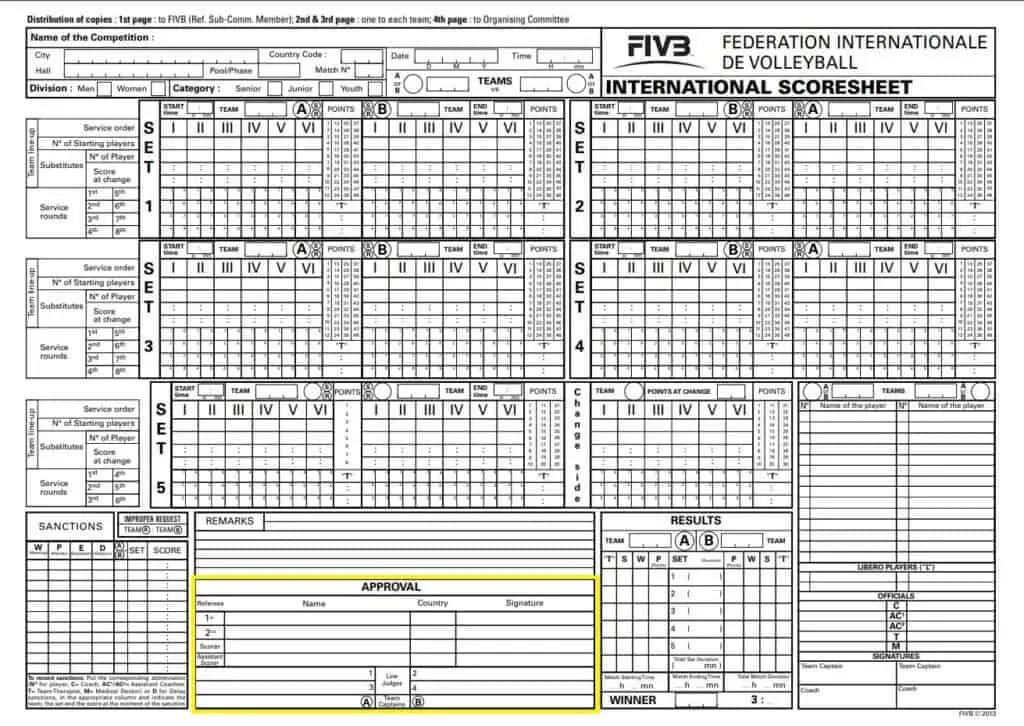
When we take a closer look at this section you will see the following headings
- Referees – 1st, 2nd, scorer, Assistant Scorer
- Name
- Country
- Signature
- Line Judges 1-4
- Team Captains

Again this one certainly isn’t positioned in a logical spot but it is at least easy to follow
Referee’s
This section is actually filled out for us as it contains the titles of the common officials, these being 1st referee, 2nd referee, scorer & assistant scorer.
Name
In this section we must determine who is in charge of each of the previously mentioned Roles and note their name down.
1st – Nuno Jimenez
2nd – Paval Stroon
Scorer – Tim Butinger
Assistant Scorer – Anja Tichnov
Country
Continuing down the line once we have written the names of each of the officials we must note their country code or abbreviation.
1st – Nuno Jimenez – ESP
2nd – Paval Stroon – NED
Scorer – Tim Butinger – CHE
Assistant Scorer – Anja Tichnov – GER
Signatures
Once the above information is filled in, each official my sign the document
Line Judges
Below this section you will note there are 4no. Boxes with the heading line judges, this is where each line judge will print their name, no signatures or country codes are required for this section.
Donald Walsh 1 2 Evelina Soffita
Geovani Tonni 3 4 Frank Troy
Team Captains
The last section is the team captains, using the previously filled in section where the players on each team entered their name you can identify the 2no. Captains from each team and note their names here.
You will be pleased to know that all steps have been completed until the serve/ receive team is identified.
After the Serve/ Receive is Determined
Once the formalities from the first section are noted down you as the scorer must go out like an investigator to obtain information from the relevant parties.
The first person you need to obtain information from is the 1st referee.
1st Referee Information
From the 1st referee you must understand which team is starting on each side of the court. Once established you are able to note each team down accordingly.
Locate the box that states Set 1 and proceed with the below.
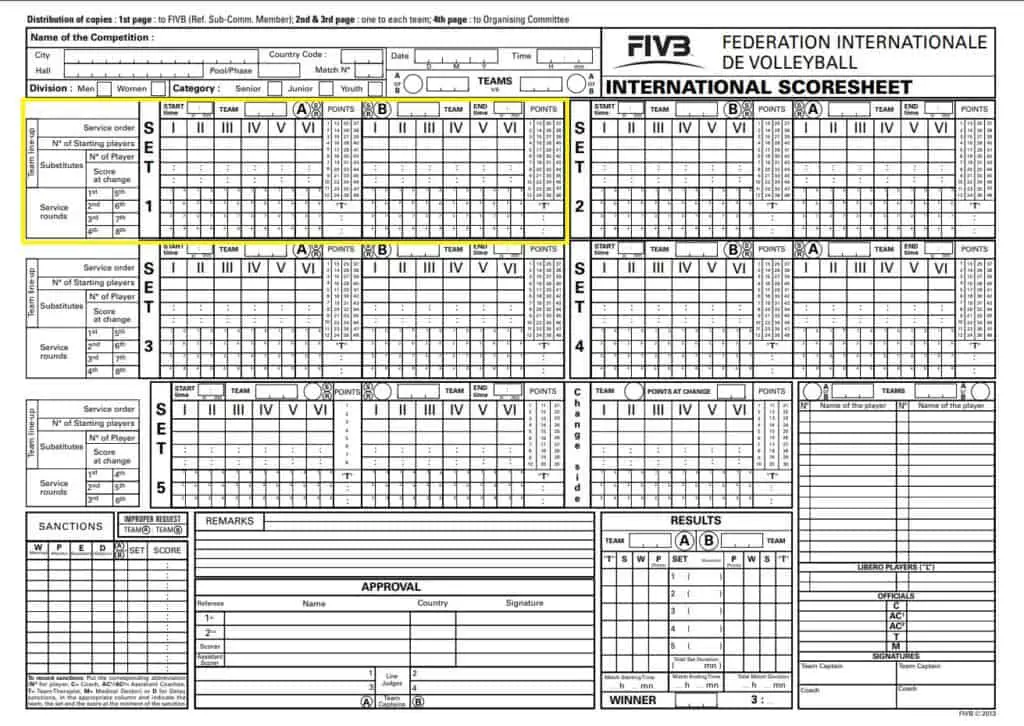
The team that is on your left as you sit at the scorers table is ‘Team A’ the Team that is starting on the right of you is ‘Team B’
Put Team A’s abbreviation in the A side of the box and Team B’s abbreviation in the B Side located as shown below,.

Once you have marked the abbreviations of each team in the appropriate side you can obtain the next piece of information from the 1st referee.
This information is which team is serving and which team is receiving.
You will notice that next to where you have just written the abbreviations of each team down there is an S and an R in a circle.
Once the referee has confirmed you can scribble out the R of the serving team and the S of the receiving team.
Once complete you can preemptively fill out the same information in Set’s 2 & 3 however it is important to remember that after each set the teams not only swap sides but the team who started serving will be receiving in the following and vice versa.
Once all of these items have been entered you must go found the second party with valuable information, this person is the 2nd referee
2nd Referee Information
Before each set is due to commence each time must fill out a lineup sheet. If you are unclear on what exactly this is I have just finished an article outlining exactly what they are and how you fill them out which you can check out here.
This Lineup sheet is what you need to collect from the 2nd referee as it contains a lot of useful information you can use to fill out the scoresheet.
You will notice in the box you have just filled out the team names in there is a section called Service Order followed by a series of roman numerals, you may have also noticed that these roman numerals are also shown on the lineup sheet you have just collected from the 2nd referee.
Under each roman numeral on the lineup sheet you will notice a jersey number, these jersey numbers represent the starting lineup of the team which help you keep track of service order and overall team lineup.
As the scorer you must copy these numbers onto the score sheet ensuring the number represented on the lineup sheet falls in the same box on the scoresheet. These numbers are to be entered in the section titled No of Starting Players.

Now I was going to give examples much like I did for the previous section but to be honest the figure they have used on the official instructions is actually really well presented and I feel it clearly shows what to expect in each section.
And that’s it your job as an investigator is over and you have compiled all the clues to put the case together.
The next stage looks at once the match has officially started.
During The Match
Now all of the preliminary information is filled in, the games can begin.
Fortunately we don’t have to scout around for the next box to continue filling out the information as we actually remain in the same set 1 box that we were previously recording information in.
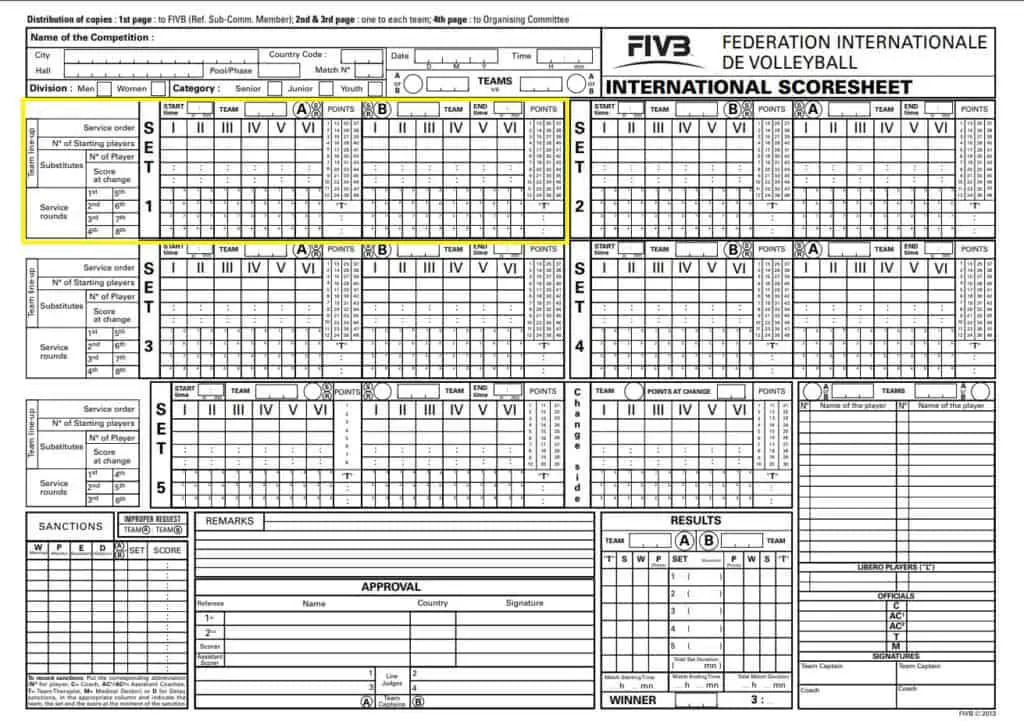
You will see that the following boxes are still yet to be filled in.
- Start Time
- Service Rounds
- Points
- Substitutions
- Time-Outs
- End Time

Start Time
As the whistle is blown to signify the start of the match the first thing you as a scorer must do is note down the exact time the match started.
An example may be: 10:08
Service Rounds
The next section we move onto is the Service rounds, this is used to help monitor which player is serving and at what point the service switched.
Once it is known which team is serving you can locate the column that contains the roman numeral 1 on the relevant side and move to the service round column.
Next to the service round you will find the 1st – 6th, this reflects how many times they have served in a set.
Starting with the 1st service round under column 1 you will ✔the top right corner of the 1st box to indicate that the server has started their service run.
When it comes to the point when the other team wins the point and ends the service run you will not the points won by the server.
Based on the match just starting, let’s say the score is 3-1.
In the 1st round service box where you have placed the tick you would note 3
When the other team wins the point from the existing serving team they must rotate clockwise one position.
This means when you move over to start marking the service rounds of team B you would put an X through service round 1 under service order 1.
This means the player who is at service order 2 will be the first server for the team.
Under service order 2 you move down the service rounds again and place the ✔ in the top round corner of the box.
Much like you did with the first service run, when the players service run comes to an end you will note score in the box.
If we use the example score of 3-3. You would note a 3 in the box.
See below figure for reference.
Once each player has had a service run the process will repeat in the 2nd service round.
This process repeats until the end of the Set.
Points
You will notice that there are 2 points columns that run from 1-48.
There is 1 column in Team A’s section and 1 column in Team B’s section.
These sections are used to keep a running tally of the score in the match.
Let’s say that Team A start serving and win the first point, You as the scorer would put a slash through the 1 in the points section on Team A’s side, for each point that Team A wins the score will continue to be slashed out.

The same is true each time Team B wins a point.
If for example the score was 4-4 you would expect to see numbers 1-4 slashed through on both Team A & B’s side.
Once a team reaches the required score of 25 points or two clear points where tied at 24, all remaining numbers after the winning numbers will be crossed out.
In the event that a 5th set is to be played to determine the winner then this set goes upto 15 points unless the teams are tied at 14-14 in which case it becomes the first team to get 2 points clear.
Substitutions
This section is as the name suggests used for recording any substitutions that may take place in the set.
As I touched on earlier when a player is substituted they can only return to the field if they are subbed back in for the player who replaced them previously.
When a substitution is to take place the number of the player that is being substituted into the game is to be written under the player’s number that they are replacing.
If the player previously substituted off is to return to play the player’s number who was originally subbed in is circled to indicate that the player is not able to return to the field until the end of the set.
Each time a substitution is made the score at the time of the substitution is to be recorded below the substituted players.

Time-Outs
So you may be looking around the box and thinking to yourself
“There isn’t the word ‘Time-Outs’ written anywhere”
Which yes you are correct, the Time-outs section is actually indicated by the following sign
“T”

You will notice there are two boxes below the T sign for both Team A and Team B, this is to accommodate for two timeouts per team, per set.
Whichever team calls the timeout the scorer must note the score at the time of the timeout in the 1st time out box.
If Team A calls the timeout the score will be noted in team A’s side whereas if Team B calls the timeout then the score would be noted on Team B’s side.
End Time
The last thing you will notice in this section is a little box in the top right which states end time.
Much like with the start time when the set comes to an end you as the scorer must note the exact time of finishing.
An example may be as follows
10:32

If you are filling out the scoresheet as we go you will notice that your sheet is starting to look very full, you may also notice that there are additional boxes that are still not filled out.
Now some of these are to be filled out after the game but there is still one box that needs to be looked out and filled out accordingly whilst the game is still going ahead.
This section is the Sanctions box.
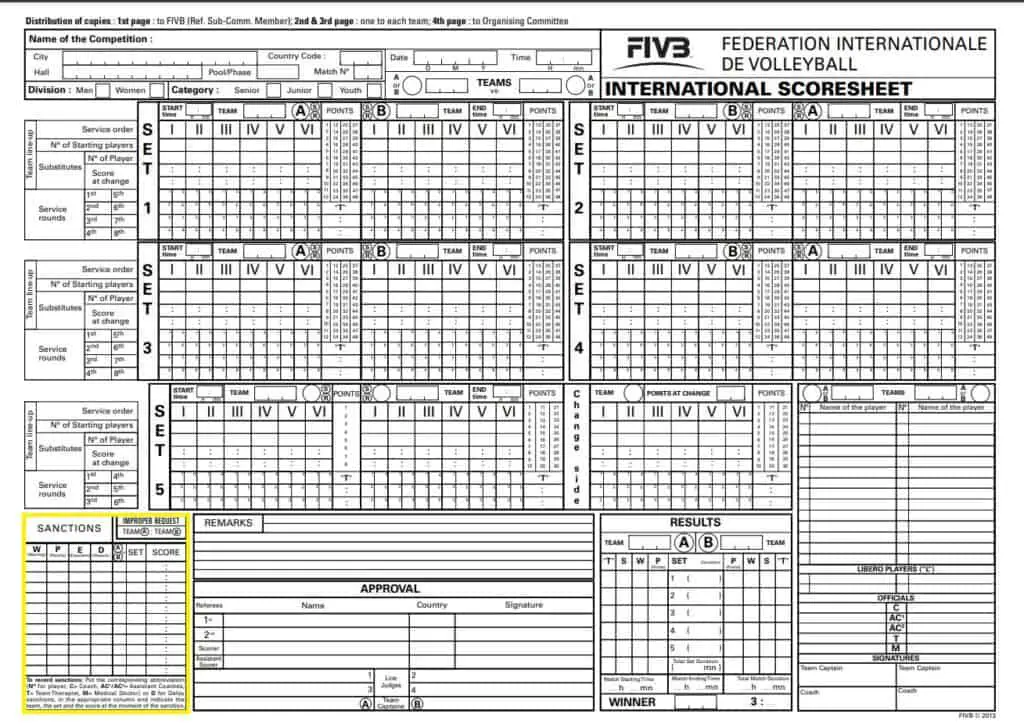
In the Sanctions Box you will find the following headings
- Improper Requests
- Sanctions, W, P, E & D
- Team A or B
- Set
- Score
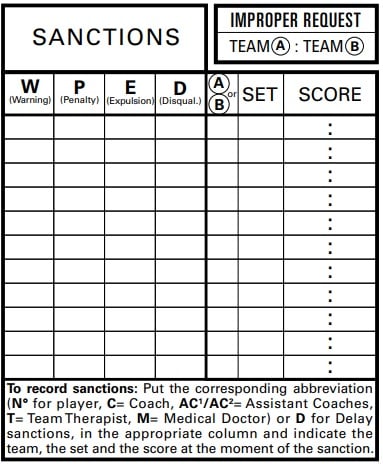
Improper Requests
Under improper requests you will see there is a Team A box and a Team B. This is used for when a request is rejected by the referee, the second a request is rejected the box of the team that had the rejected request should be marked with an X, where the request repeats it will be marked down as a sanction and the appropriate action will be taken in the form of points awarded to the non-offending team.
Sanctions, W, P, E & D
This section is used to mark any sanctions given out by the officials throughout the match.
W = Warnings
P = Penalties
E = Explosions
D = Disqualifications
When one of the above occurs the scorer must note the number of the offending player or alternatively the initial of the official who gave out the sanction.
The preferred option is to note the player however if the official is keeping track and the game is getting out of hand it is sometimes easier to mark the officials initials.
There is however one exception to this rule, if the fault is a delay in play then as this can be a result of a full team, coaching staff or even fans then instead of a player number or officials initials the appropriate note is to place a ‘D’ in the appropriate box
Team A or B
Once the sanction has been marked down we move over to the next column which is Team A or B.
This section is used to note which Team had the sanction for example if Team A delayed play, this would be noted on the sanction list and an A would be placed under the Team column.
Set
The next column along is Set this is used to note which set the sanction was in.
Continuing with the above example if Team A delayed play and received a penalty in the 2nd set then you as the scorer would not 2 in this column
Score
The last column in this section is score.
This is used to note the score at the time the sanction was awarded.
Using the above example still, if it was the second set and the score was 18:17 when the sanction occurred, this would be noted in the final column like so: 18:17
When a sanction occurs and it results in a point and service being awarded to the other team this is noted in the points column from the last section and the number is circled to indicate how and when the point was awarded.
Please see below example taken from the official FIVB Guide
And there you have the end of the game.
Unfortunately though your job as a respectable scorer isn’t quite finished yet.
We now move into the final category After the Match
After the Match
Don’t worry you are really close. All of the hard work is out of the way and now it’s time to compile all the scores to form the final results in a clear and concise table.
This table is aptly called Results and can be located at the bottom right of the page.
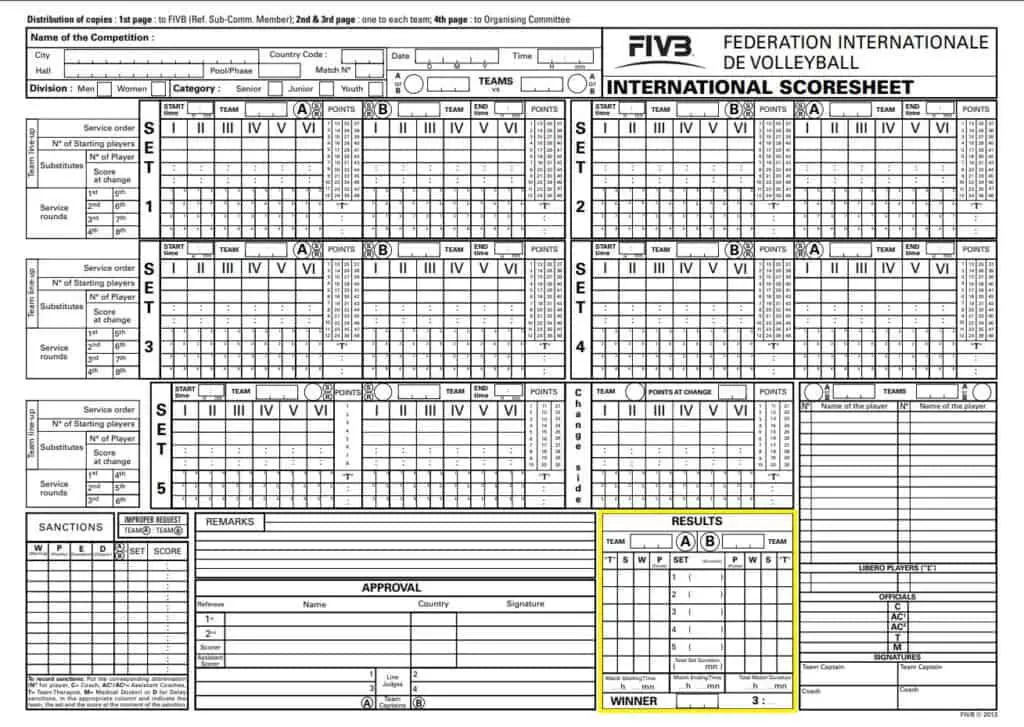
As we take a closer look at this results table we will see the following headings.
- Team
- “T”
- S
- W
- P (points)
- Set
- Duration
- Total Set Duration
- Match Start Time
- Match Ending Time
- Total Match Duration
- Winner
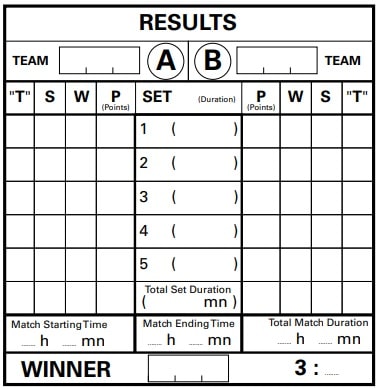
Now I know it’s a lot of headings but thankfully each heading should be quick and easy to explain and also fill in, so let’s dive into it.
Team
Hopefully this is starting to look very familiar as you have already filled this same section out many times.
In this bit you should write down the abbreviation (or country code) of both Team A & Team B.
Using our previous example it would look like this: PPN VS RHP
“T”
Again im sure you recognise this sign from before but this is the time-out symbol, in this column you will note the number of time-outs each time had per set, for example is team A had 2 timeouts in set 1 and Team B had 1 you would note 2 in the 1st box of the Timeouts column on Team A and 1 in the side of Team B
S
The S represents Substitutions much like with the timeouts you will note down how many subs Team A used in each set as well as how many subs Team B used.
An example would 3 subs for Team A in set 1, in the 1st box of the S column you would simply write 3 in the box
W
The W simply means the winner of the set.
Where a team wins the set a 1 will be written whilst the losing team will have a 0 noted down.
In set 1 if Team A wins the set and Team B Loses it would be recorded in the following way
Team A will have a 1 noted down whereas Team B will have a 0
P (points)
As it states in the brackets this column is where the points of each team will be noted for each set.
Sticking with the set 1 theme is Team A scores 25 points and Team scores 22 both point totals would be noted in the appropriate box.
Team A will have 25 noted down whereas Team B will have 22.
Set
This column is actually already completed for us, this column simply contains a count from 1 to 5.
This represents each set that could be played throughout the full match.
Duration
Duration is used to fill out the how long each set lasted.
The durations will be noted against each of the set numbers.
An example would be if set 1 lasted 22 minutes this would be noted in the duration column.
Total Set Duration
In this column we simply need to add up each of the set durations above and total them up in this box.
If for example 5 Sets were played and the durations were as follows:
Set 1 = 22
Set 2 = 28
Set 3 = 32
Set 4 = 21
Set 5 = 18
The total set duration would be entered in the following way:
( 121 min )
Match Start Time
In this box you must simply enter the very first start time you recorded an example from earlier would be as follows: 10h 08mn
Match Ending Time
In this box you must enter the final match ending time you recorded, in the example above this would be the last time from set 5
An example would be: 12h 02mn
Total Match Duration
The total match duration is the time elapsed between the Match start start time and the match end time.
Using the times noted above this would be as follows: 1h 54mn
Winner
This sums you up well as you have finally reached the last section, recording the winner of the match.
In this section you will note the abbreviation for the winning team and then you will note the final score in sets an example would be as per the below.
Winner PPN 3:2
Again FIVB have actually got a fantastic example straight on the instructions so I will use this to show how the form will come together.
So you may have noticed that there is still one box that is not filled out and has not been talked about, this box is the Remarks box
Remarks
Now the main reason I didn’t mention the remarks box is because it’s not frequently used and for the most part when it is used I wish it wasn’t.
The remarks box is reserved for making notes where special circumstances have taken place and can be found in the lower half of the page just left of the centre of the page.
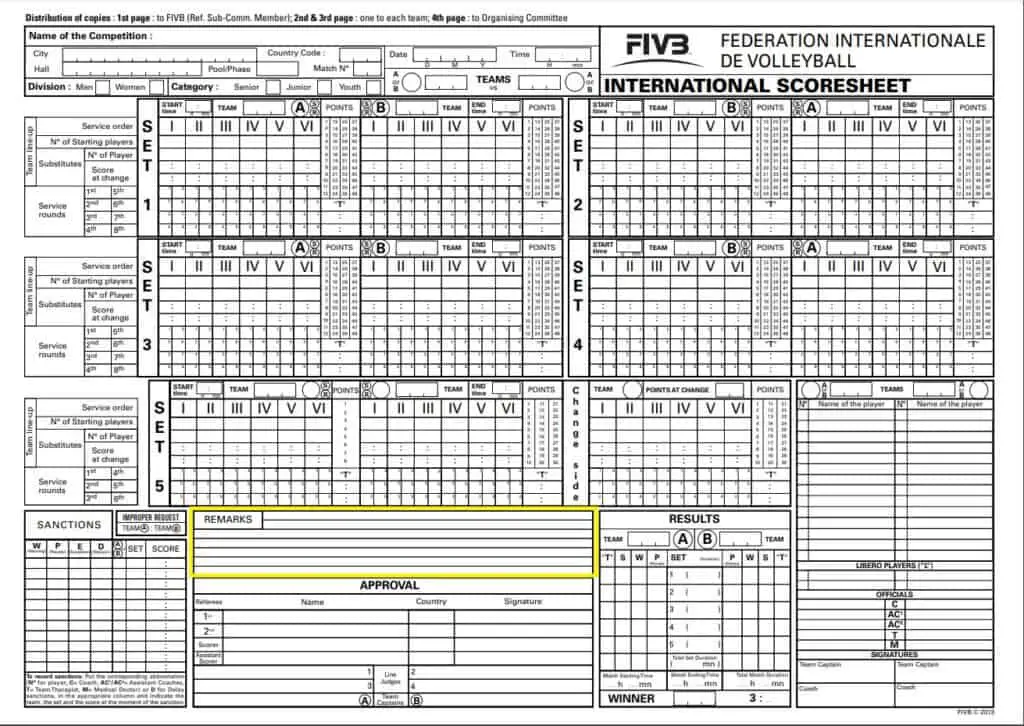
The usual reason in which this is used is when a substitution takes place due to an injury and the injured player is too badly injured to return to the field.
There is no real official way to fill this section out so if you are required to use it just make sure the comments are clear and concise to ensure whoever picks up the sheet can read and understand the comment.
So that’s it, you have finally got to the end of the scoresheet.
I have tried very hard to ensure each item is broken down, displayed and laid out as clearly as possible to ensure you fully understand each area of the scoresheet.
Hopefully this article has been beneficial and you now feel confident enough to take the stand and score that next match.
For those of you who are here for the free downloadable sheet you can click on the below link to get access to your downloadable PDF printout.


